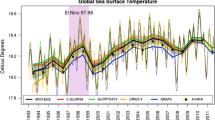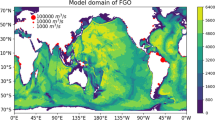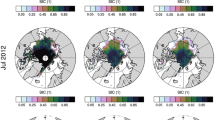Abstract
A new eddy-permitting ocean reanalysis has been recently completed at ECMWF. It is called Ocean ReAnalysis Pilot 5 (ORAP5), and it spans the period 1979–2012. This work describes the new system, evaluates its performance, and investigates how the estimation of climate indices are affected by the assimilation system settings. ORAP5 introduces several upgrades with respect to its predecessor ORAS4, including increased horizontal and vertical resolution, an prognostic sea-ice component, new versions of the ocean and data assimilation system, revised surface fluxes, new version and treatment of satellite sea surface height data, and assimilation of sea-ice concentration, among others. ORAP5 shows similar performance to ORAS4, with improvements in the northern extratropics (especially in salinity), and slight degradation in the Southern Ocean, probably because the observations are insufficient to constrain the increased level of variability in ORAP5. The sensitivity experiments show that superobbing of altimeter data and correlation length-scales of the background errors have a visible impact on the time evolution of global steric height and its partition into thermo/halo-steric contributions. The sensitivities are especially large in the pre-Argo period, when there is the risk of producing unrealistic steric height variations by overfitting the altimeter data. Compared with a control run without data assimilation, all the assimilation experiments also show stronger variability in the halosteric component in the pre-Argo period. The results highlight the importance of sub-surface observations to assist the assimilation of altimeter data, and the need of using a variety of metrics for evaluating ocean reanalysis systems.











Similar content being viewed by others
References
Ablain M, Cazenave A, Larnicol G, Balmaseda MA, Cipollini P, Faugère Y, Fernandes M, Henry O, Johannessen J, Knudsen P et al (2015) Improved sea level record over the satellite altimetry era (1993–2010) from the Climate Change Initiative Project. Ocean Sci Discuss 11(4):2029–2071
Amante C, Eakins BW (2009) ETOPO1 1 arc-minute global relief model: procedures, data sources and analysis. US Department of Commerce, National Oceanic and Atmospheric Administration, National Environmental Satellite, Data, and Information Service, National Geophysical Data Center, Marine Geology and Geophysics Division
Antonov J, Seidov D, Boyer T, Locarnini R, Mishonov A, Garcia H, Baranova O, Zweng M, Johnson D (2010) World Ocean Atlas 2009, volume 2: salinity. In: Levitus S (ed) NOAA Atlas NESDIS 69, p 184
Balmaseda MA, Dee D, Vidard A, Anderson D (2007) A multivariate treatment of bias for sequential data assimilation: Application to the tropical oceans. Q J R Meteorol Soc 133(622):167–179
Balmaseda MA, Fujii Y, Alves O, Lee T, Rienecker M, Rosati T, Stammer D, Xue Y, Freeland H, McPhaden MJ et al (2010) Role of the ocean observing system in an end-to-end seasonal forecasting system. In: Proceedings of oceanobs 9
Balmaseda MA, Mogensen K, Weaver AT (2013a) Evaluation of the ECMWF ocean reanalysis system ORAS4. Q J R Meteorol Soc 139(674):1132–1161
Balmaseda MA, Trenberth KE, Källén E (2013b) Distinctive climate signals in reanalysis of global ocean heat content. Geophy Res Lett 40(9):1754–1759
Balmaseda MA, Hernandez F, Storto A, Palmer MD, Alves O, Shi L, Smith GC, Toyoda T, Valdivieso M, Barnier B et al (2015) The Ocean Reanalyses Intercomparison Project (ORA-IP). In: Proceedings of the Institute of Marine Engineering, Science, and Technology, Journal of Operational Oceanography
Barnier B, Madec G, Penduff T, Molines JM, Treguier AM, Le Sommer J, Beckmann A, Biastoch A, Böning C, Dengg J et al (2006) Impact of partial steps and momentum advection schemes in a global ocean circulation model at eddy-permitting resolution. Ocean Dyn 56(5–6):543–567
Bloom S, Takacs L, Da Silva A, Ledvina D (1996) Data assimilation using incremental analysis updates. Mon Weather Rev 124(6):1256–1271
Breivik Ø, Mogensen K, Bidlot JR, Balmaseda MA, Janssen PA (2015) Surface wave effects in the NEMO ocean model: forced and coupled experiments. J Geophys Res
Cazenave A, Larnicol G, Legeais JF, Ablain M, Faugre Y, Mbajon Njiche S, Timms G, Meyssignac B, Balmaseda M, Zuo H, Johannessen J, Scharffenberg M, Stammer D, Andersen O, Knudsen P, Zawadzki L, Thibaut P, Poisson JC, Picard B, Carrre L, Mertz F, Lauret O, Rudenko S, Farquhar C, Pechorro E, Roca M, Nilo P, Cipollini P, Calafat F, Fernandes J, Lazaro C, Quartly G, Kurekin A, Nencioli F, Fenoglio-Marc L, Benveniste J, Lucas B, Dinardo S, Ambrzio A (2014) Sea level essential climate variable products, Version 1.1. ESA Sea Level Climate Change Initiative (ESA SL\_cci). doi:10.5270/esa-sea_level_cci-1993_2013-v_1.1-201412
Chen X, Tung KK (2014) Varying planetary heat sink led to global-warming slowdown and acceleration. Science 345(6199):897–903
Chevallier M et al (2015) Uncertainties in the Arctic sea ice cover in state-of-the-art ocean reanalyses from the ORA-IP project. Clim Dyn S.I Ocean Reanal
Church JA, White NJ (2011) Sea-level rise from the late 19th to the early 21st century. Surv Geophys 32(4–5):585–602
Dai A, Trenberth KE (2002) Estimates of freshwater discharge from continents: latitudinal and seasonal variations. J Hydrometeorol 3(6):660–687
Dee DP, Uppala SM, Simmons AJ, Berrisford P, Poli P, Kobayashi S, Andrae U, Balmaseda MA, Balsamo G, Bauer P, Bechtold P, Beljaars ACM, van de Berg L, Bidlot J, Bormann N, Delsol C, Dragani R, Fuentes M, Geer AJ, Haimberger L, Healy SB, Hersbach H, Hólm EV, Isaksen L, Kållberg P, Köhler M, Matricardi M, McNally AP, Monge-Sanz BM, Morcrette JJ, Park BK, Peubey C, de Rosnay P, Tavolato C, Thépaut JN, Vitart F (2011) The ERA-Interim reanalysis: configuration and performance of the data assimilation system. Q J R Meteorol Soc 137(656):553–597. doi:10.1002/qj.828
Donlon CJ, Martin M, Stark J, Roberts-Jones J, Fiedler E, Wimmer W (2012) The operational sea surface temperature and sea ice analysis (OSTIA) system. Remote Sens Environ 116:140–158
Drijfhout S, Blaker A, Josey S, Nurser A, Sinha B, Balmaseda M (2014) Surface warming hiatus caused by increased heat uptake across multiple ocean basins. Geophys Res Lett 41(22):7868–7874
ECMWF (2013) IFS documentation CY40R1, part VII: ECMWF Wave Model. ECMWF Tech Memo (79)
England MH, McGregor S, Spence P, Meehl GA, Timmermann A, Cai W, Gupta AS, McPhaden MJ, Purich A, Santoso A (2014) Recent intensification of wind-driven circulation in the Pacific and the ongoing warming hiatus. Nat Clim change 4(3):222–227
Fichefet T, Maqueda M (1997) Sensitivity of a global sea ice model to the treatment of ice thermodynamics and dynamics. J Geophys Res Oceans (1978–2012) 102(C6):12,609–12,646
Guemas V, Doblas-Reyes FJ, Lienert F, Soufflet Y, Du H (2012) Identifying the causes of the poor decadal climate prediction skill over the north pacific. J Geophys Res Atmos 117(D20)
Gürol S, Weaver A, Moore A, Piacentini A, Arango H, Gratton S (2014) B-preconditioned minimization algorithms for variational data assimilation with the dual formulation. Q J R Meteorol Soc 140(679):539–556
Hay CC, Morrow E, Kopp RE, Mitrovica JX (2015) Probabilistic reanalysis of twentieth-century sea-level rise. Nature
Ingleby B, Huddleston M (2007) Quality control of ocean temperature and salinity profiles-historical and real-time data. J Mar Syst 65(1):158–175
Janssen P, Brevivik O, Mogensen K, Vitart F, Balmaseda MA, Bidlot JR, Keeley S, Leutecher M, Magnusson L, Molteni F (2013) Air-sea interaction and surface waves. ECMWF Tech Memo (712)
Karspeck A et al (2015) Comparison of the Atlantic meridional overturning circulation between 1960 and 2007 in six different ocean reanalysis products. Clim Dyn S.I Ocean Reanal
Large W, Yeager S (2009) The global climatology of an interannually varying air-sea flux data set. Clim Dyn 33(2–3):341–364
Lefèvre F, Doradeu J, Sénant E et al (2005) Monitoring of the ENVISAT altimeter drift with a specific tide gauge database. In: Workshop on sea level variations towards an operational European sea level service p 64
Locarnini R, Mishonov A, Antonov J, Boyer T, Garcia H, Baranova O, Zweng M, Johnson D (2010) World Ocean Atlas 2009, volume 1: temperature. In: Levitus S (ed) NOAA Atlas NESDIS 68, p 184
Madec G (2008) NEMO ocean engine. Note du Pôle de modélisation, Institut Pierre-Simon Laplace (IPSL), France, No 27. ISSN No 1288-1619
Mayer M, Haimberger L, Balmaseda MA (2014) On the energy exchange between tropical ocean basins related to ENSO. J Clim
Mogensen K, Balmaseda MA, Weaver A (2012) The NEMOVAR ocean data assimilation system as implemented in the ECMWF ocean analysis for system 4. ECMWF Tech Memo (668)
Palmer M et al (2015) Ocean heat content variability and change in an ensemble of ocean reanalyses. Clim Dyn S.I Ocean Reanal
Pohlmann H, Müller WA, Kulkarni K, Kameswarrao M, Matei D, Vamborg FSE, Kadow C, Illing S, Marotzke J (2013) Improved forecast skill in the tropics in the new miklip decadal climate predictions. Geophys Res Lett 40(21):5798–5802
Reynolds RW, Smith TM, Liu C, Chelton DB, Casey KS, Schlax MG (2007) Daily high-resolution-blended analyses for sea surface temperature. J Clim 20(22):5473–5496
Roberts-Jones J, Fiedler EK, Martin MJ (2012) Daily, global, high-resolution SST and sea ice reanalysis for 1985–2007 using the OSTIA system. J Clim 25(18):6215–6232
Shi L et al (2015) Assessment of upper ocean salinity content from the Ocean Reanalyses Inter-Comparison Project (ORA-IP). Clim Dyn S.I Ocean Reanal
Simmons A, Uppala S, Dee D, Kobayashi S (2007) ERA-interim: New ECMWF reanalysis products from 1989 onwards. ECMWF Newslett 110
Tapley BD, Bettadpur S, Ries JC, Thompson PF, Watkins MM (2004) GRACE measurements of mass variability in the earth system. Science 305(5683):503–505
Tietsche S, Balmaseda MA, Zuo H, Mogensen K (2014) Arctic sea-ice in the ECMWF MyOcean2 ocean reanalysis ORAP5. ECMWF Tech Memo (737)
Toyoda T et al (2015a) Interannual-decadal variabilities of wintertime mixed layer depths in the North Pacific observed in an ensemble of ocean syntheses. Clim Dyn S.I Ocean Reanal
Toyoda T et al (2015b) Intercomparison and validation of the mixed layer depth fields of global ocean syntheses/reanalyses. Clim Dyn S.I Ocean Reanal
Uppala SM, Kållberg P, Simmons A, Andrae U, Bechtold V, Fiorino M, Gibson J, Haseler J, Hernandez A, Kelly G et al (2005) The ERA-40 reanalysis. Q J R Meteorol Soc 131(612):2961–3012
Waters J, Lea DJ, Martin MJ, Mirouze I, Weaver A, While J (2014) Implementing a variational data assimilation system in an operational 1/4 degree global ocean model. Q J R Meteorol Soc 141(687):333–349. doi:10.1002/qj.2388
Weaver AT, Deltel C, Machu É, Ricci S, Daget N (2005) A multivariate balance operator for variational ocean data assimilation. Q J R Meteorol Soc 131(613):3605–3625
Wijffels SE, Willis J, Domingues CM, Barker P, White NJ, Gronell A, Ridgway K, Church JA (2008) Changing expendable bathythermograph fall rates and their impact on estimates of thermosteric sea level rise. J Clim 21(21):5657–5672
Zhu J, Huang B, Marx L, Kinter JL, Balmaseda MA, Zhang RH, Hu ZZ (2012) Ensemble ENSO hindcasts initialized from multiple ocean analyses. Geophys Res Lett 39(9)
Zhu J, Huang B, Balmaseda MA, Kinter JL III, Peng P, Hu ZZ, Marx L (2013) Improved reliability of ENSO hindcasts with multi-ocean analyses ensemble initialization. Clim Dyn 41(9–10):2785–2795
Zuo H, Balmaseda MA, Haines K, Valdivieso MSM, Storto A, Parent L (2015a) The ECMWF-MyOcean2 eddy-permitting ocean and sea-ice reanalysis ORAP5. Part II: comparison with other MyOcean ocean reanalyses. ECMWF Tech Memo (in preparation)
Zuo H, Balmaseda MA, Mogensen K (2015b) The ECMWF-MyOcean2 eddy-permitting ocean and sea-ice reanalysis ORAP5. Part I: Implementation. ECMWF Tech Memo (736)
Acknowledgments
This work has been carried out under the support of EU MyOcean2 project and the ESA CCI initiative. Thanks to Jean Marc Molines from LGGE and Andrew Coward from NOCS for providing the input files for the DRAKKAR reference NEMO ORCA025 configurations and assisting with the implementation of NEMO. Thanks to the members of the NEMOVAR team. We would also like to thank the three anonymous reviewers for their constructive comments.
Author information
Authors and Affiliations
Corresponding author
Additional information
This paper is a contribution to the special issue on Ocean estimation from an ensemble of global ocean reanalyses, consisting of papers from the Ocean Reanalyses Intercomparsion Project (ORAIP), coordinated by CLIVAR-GSOP and GODAE OceanView. The special issue also contains specific studies using single reanalysis systems.
Rights and permissions
About this article
Cite this article
Zuo, H., Balmaseda, M.A. & Mogensen, K. The new eddy-permitting ORAP5 ocean reanalysis: description, evaluation and uncertainties in climate signals. Clim Dyn 49, 791–811 (2017). https://doi.org/10.1007/s00382-015-2675-1
Received:
Accepted:
Published:
Issue Date:
DOI: https://doi.org/10.1007/s00382-015-2675-1




